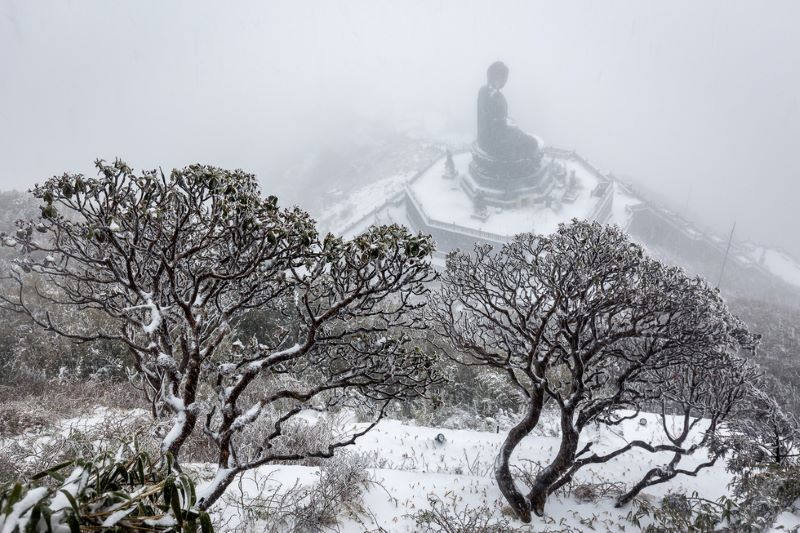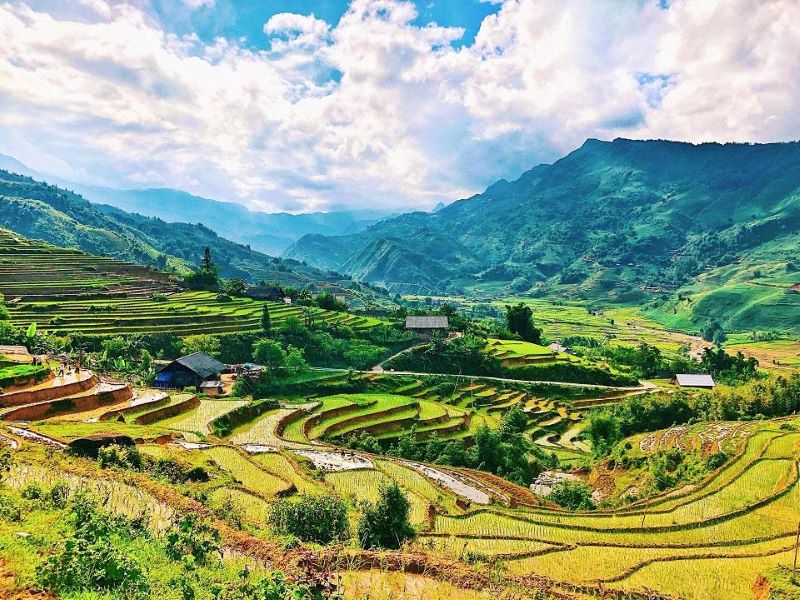Sapa in January is considered the ideal time to explore this charming town, especially for those who love a winter experience. Despite the cold weather and fog, Sapa captivates with its breathtaking winter scenery, featuring snow-covered mountains and frosty landscapes. Discover valuable tips and insights to enjoy the enchanting natural beauty of Sapa in January fully.
Is Sapa in January an ideal time to travel?
If you’re unsure whether to visit Sapa in January, let’s explore the weather and exciting activities during this time. The information below will give you a clearer understanding of what Sapa in January has to offer, from the weather to particular activities, helping you quickly make your decision and plan your trip:
The weather characteristics of Sapa in January
January is the middle of winter in Sapa and also the coldest month of the year; during this time, the average temperature in Sapa is around 14°C, but it can drop as low as 0°C on cold days. The winter in Sapa is often accompanied by thick fog, which makes the scenery feel mysterious and dreamy. The rainfall in January is not too heavy, with an average of around 57.4 mm and approximately 6.6 rainy days throughout the month. The humidity is relatively high, reaching around 78.8%, creating a cold and damp atmosphere and offering a fresh.

These specific weather conditions provide an excellent opportunity for visitors to explore the majestic nature of Sapa, enjoy warm local specialties, and learn about the diverse culture of the ethnic minorities living here. The cold and misty days create a unique atmosphere that helps you immerse yourself in the pristine beauty of the region. If you’re lucky, you might even witness the stunning sight of snow falling, covering the mountains, and creating a frozen, magical space full of romance.
Admire the vibrant beauty of the flowers
In January, the weather in Sapa undergoes a magical transformation, with the entire region donning a new, vibrant, and colorful coat. As winter gradually fades, the signs of spring start to appear everywhere, particularly in the blooming of characteristic flowers. Delicate peach blossoms, from wild varieties to Japanese peach, greet the arrival of spring. These flowers not only beautify the landscape but also symbolize rebirth, vitality, and the fresh beauty of Sapa in the early days of the year.

As you stroll along the narrow paths and climb the hillsides of Sapa in January, you’ll find yourself immersed in a sea of plum and apricot flowers, their pure white blossoms painting a perfect scene across the villages and hills. The purity and freshness of these flowers evoke awe and admiration in the hearts of travelers, transforming every corner into a picturesque oasis.

The plum and apricot flowers in Sapa in January are not just ordinary blooms but carry deep emotions, evoking feelings of peace and serenity. Each village and hillside turns into a living canvas, making every visitor feel like they’ve stepped into a different world, full of poetry and charm. This sensation makes each step a journey of discovering the pristine, peaceful, and unforgettable beauty of nature.
Places to visit when traveling to Sapa in January
Once you’ve learned about the weather in Sapa in January, don’t forget to plan your visit to explore the iconic landmarks of this stunning region. Sapa not only attracts visitors with its majestic natural beauty but also with its unique destinations where you can experience distinct cultural features. These places are sure to offer unforgettable experiences, making your trip even more meaningful:
Fansipan Mountain – Known as the Roof of Indochina
Fansipan Mountain, also known as the “Roof of Indochina,” is an unmissable destination when traveling to Sapa. With an elevation of 3,143 meters, Fansipan offers adventure seekers the chance to challenge themselves with trekking routes through rugged forests and steep paths. This journey not only tests the limits of outdoor enthusiasts but also provides an opportunity to admire the majestic beauty of Sapa’s natural landscape. The towering mountains, endless forests, and colorful flowers create stunning, unforgettable scenery.

For those who prefer a more leisurely experience, the world’s longest-rope cable car system offers an easier way to reach the summit of Fansipan while providing panoramic views of the majestic mountain range, vast forests, and snow-covered landscapes. At the summit, visitors can also marvel at the massive 62-ton statue of Buddha Amitabha, an essential Buddhist landmark in Vietnam, which brings a sense of tranquility and peace to the soul.
O Quy Ho Pass – A stunning place for cloud hunting
O Quy Ho Pass is one of the most famous and challenging mountain roads in the Northwest region of Vietnam, especially for those who love adventure. Located at an altitude of over 2,000 meters, O Quy Ho Pass is nestled between the misty sky and endless mountain ranges, creating a majestic landscape, resembling a silk ribbon stretching across the cliffs. This winding road attracts not only thrill-seekers but also mesmerizes travelers with its pristine beauty and the mysteriousness of nature in this area.

Standing at the summit of the pass, visitors are overwhelmed by the grandeur of the scenery, where the mountains are shrouded in mist or blanketed in snow during the winter. Every viewpoint from the top offers a stunning natural landscape full of romance and tranquility. The vast forests and deep valleys hidden among the floating clouds create a magical and unforgettable atmosphere, leaving anyone who visits with lasting memories of this breathtaking beauty.
Ham Rong Mountain – One of the most famous mountains in Sapa
Ham Rong Mountain is one of the must-visit destinations when traveling to Sapa, especially in January. With its unique shape, the rocky mountain range looks like a giant dragon from a distance, offering breathtaking views. During winter, the landscape becomes even more mystical and enchanting as the area is covered in mist and cold air, creating a beauty that is both dreamy and majestic. Nature lovers will be mesmerized by the charm of Hàm Rồng Mountain.

In addition to its natural beauty, Hàm Rồng Mountain is also a place where unique cultural values come together. As you ascend the mountain, you can not only admire the blooming azaleas and peach flowers but also participate in traditional cultural activities of the H’mong people. The vibrant folk performances by the young H’mong people in traditional costumes will make the visit even more lively and memorable.
Muong Hoa Valley – A green gem nestled among the mountains
Muong Hoa Valley in January is a fantastic destination that you cannot miss when visiting Sapa. It stands out with its lush, terraced rice fields winding through the valley, creating a majestic and poetic natural landscape. The clear stream meanders through the area, bringing a sense of peace and tranquility, while the vast space of Mường Hoa becomes even more mystical under the delicate winter mist.

In addition to its breathtaking natural beauty, Mường Hoa is also home to the rich cultural heritage of the ethnic minorities. Visitors can explore famous villages such as Cat Cat and Ta Phin, where peach and apricot flowers bloom in winter, creating a picturesque scene. Moreover, you will have the opportunity to experience the daily life of the local people, taste traditional dishes, and gain a deeper understanding of the culture of the Hmong, Dao, and Tay ethnic groups.
Sapa in January, some experiences to try when visiting
Here are the most exciting experiences to try in Sapa in January that will make your trip even more memorable:
Hiking and Mountain Climbing: Winter in Sapa brings a stunning landscape with snow-covered mountains and icy scenery. Hiking and mountain climbing are perfect activities for visitors to enjoy the pristine beauty of this region fully. You’ll have the chance to admire the breathtaking natural beauty and experience the fresh, peaceful atmosphere that fills the air.

Visiting Local Markets: The markets in Sapa are famous and offer an exciting experience for travelers who want to learn more about the culture and daily life of the local people. Bac Ha Market, held every Sunday, is the largest and most prominent market in the area. Here, you can find intricate handcrafted products, unique ethnic clothing, and fresh produce grown by the local people. Each stall at the market reflects the rich cultural identity of the ethnic minorities, making it the perfect place to explore.
Relaxing in Hot Springs: After a long day of exploration, relaxing in the hot springs is a great option to restore your health and warm your body. Sapa boasts many natural hot springs, such as Bản Hồ and Tả Phìn. The hot spring water helps relax your body, ease fatigue, and provide a wonderful sense of tranquility. It’s an ideal spot to rest after a tiring day and also an opportunity to enjoy the quiet, peaceful surroundings, fully immersed in nature.

Admiring Waterfalls and Terraced Fields: Sapa is famous for its majestic waterfalls and picturesque terraced fields. In winter, the waterfalls take on a more mystical quality as they are enveloped in a misty veil. The lush green terraced fields wind beautifully across the mountain slopes, creating a breathtaking natural picture. Especially in January, the scenery becomes even more magical, with a thin layer of mist covering every corner, giving everything an ethereal and enchanting look.
Staying with Locals: One of the most memorable experiences in Sapa is staying with the ethnic minority communities. January is the festival month for many of these communities, and you will have the chance to participate in unique cultural activities and explore their colorful traditional rituals. Staying with the local people will give you a deeper understanding of their lifestyle, customs, and the traditions of ethnic groups such as the Hmong, Dao, and Tay.
What should you know when traveling to Sapa in January?
In January, the weather in Sapa is typically cold with frequent fog, so here are some essential items we highly recommend you bring to make your trip to Sapa in January more comfortable and warm:
Sapa in January has very low temperatures, especially at night, so you should bring thick sweaters and coats to keep warm. A waterproof jacket is also essential, as it will help keep you dry and warm during rainy or misty days.

To protect your head and ears from the cold, make sure to bring a hat. It’s best to choose one made of wool or leather, as they keep you warm, are easy to wear, and feel comfortable. The hat will help protect your head and ears from the cold wind, especially during misty days.
Our hands are very prone to getting cold, so leather or wool gloves are a must-have item. Without gloves, your hands may not stay warm enough to function correctly, and you might even have trouble putting them in your pockets.

Sapa is still a small town, so it can be difficult to find the medications you’re used to. If you are prone to health issues like sinus problems or sore throats, don’t forget to bring your own medicine. Prepare some essential medications to ensure your health is well taken care of during your trip.
We hope the information above will help you have a smooth and enjoyable trip to Sapa in January, creating unforgettable memories. If you choose Sapa as your destination in January, be sure to contact Meditours to enjoy the best Sapa tours and unique experiences.



